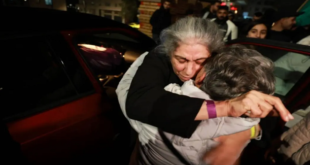On December 26, tearful mourners gathered in prayer as memorial ceremonies commenced across Asia, honoring the memory of 220,000 souls lost two decades ago to a catastrophic tsunami that struck coastal regions around the Indian Ocean, marking one of the gravest natural calamities in history.
The disaster was triggered by a 9.1-magnitude earthquake that occurred off the western coast of Indonesia on December 26, 2004, unleashing a devastating series of colossal waves that crashed against the shores of 14 nations, from Indonesia to Somalia.
In Aceh Province, Indonesia, where over 100,000 lost their lives, a siren echoed from the Baiturrahman Grand Mosque, signaling the beginning of memorial observances throughout the region, with gatherings also taking place in Sri Lanka, India, and Thailand, nations that faced the tsunami several hours later.
“I thought it was the end of the world,” reflected Hasnawati, a 54-year-old teacher, at the Indonesian mosque impacted by the disaster.
“One Sunday morning, my family was joyful together, and suddenly a calamity struck, sweeping everything away. Words fail to express it,” he recounted.
Some mourners wept at Ulee Lheue mass grave in Aceh, where approximately 14,000 are interred, while various villages held their own prayer sessions in remembrance of the tragedy that obliterated entire communities.
Later, Indonesians will pay their respects at a larger mass grave and take part in a communal prayer in Banda Aceh, the provincial capital. Concurrently, beachside memorials and religious ceremonies will commence in Sri Lanka, India, and Thailand, some of the nations hardest hit.
The waves, reaching heights of up to 30 meters, tragically took the lives of many foreign tourists who were celebrating Christmas along the region’s idyllic beaches, bringing the catastrophe into homes worldwide.
The underwater earthquake generated waves traveling at speeds surpassing that of a bullet train, crossing the Indian Ocean in mere hours.
In Thailand, where approximately half of the more than 5,000 victims were foreign holidaymakers, commemorations began in Ban Nam Khem, recognized as the worst-hit village.
Grieving relatives placed flowers and wreaths at a memorial designed like a tsunami wave, inscribed with the names of the deceased.
Napaporn Pakawan, 55, shared her loss of her older sister and niece. “I feel despair; I come here annually,” she expressed. “Time moves on, yet it feels slow in our minds.”
Unofficial beach vigils were anticipated to complement the official Thai government memorial ceremony, which included candlelight and train vigils.
According to Em-dat, a credible global disaster registry, the total casualties from the tsunami reached 226,408.
Despite it taking hours for waves to impact different continents, no warning was issued, leaving little time for evacuation. Today, a comprehensive network of monitoring stations has significantly improved warning times.
Indonesia faced the most severe toll, losing over 160,000 lives along its western shores.
“It feels as though it just occurred yesterday. Whenever it comes to mind, it feels like all the blood drains from my body,” recounted Ms. Nilawati, a 60-year-old Indonesian housewife who lost both her son and mother.
The disaster also brought an end to a prolonged separatist conflict in Aceh, culminating in a peace agreement between rebels and Jakarta less than a year after.
In Sri Lanka, where over 35,000 perished, survivors and family members gathered to remember approximately 1,000 victims who died when waves derailed a passenger train.
Mourners will board the restored Ocean Queen Express and travel to Peraliya, the site where the train was violently uprooted, located roughly 90 kilometers south of Colombo.
A brief religious service will take place with the relatives of the deceased, while various ceremonies hosted by Buddhist, Hindu, Christian, and Muslim communities will also honor the victims across the South Asian island.
Casualties were felt even in far-flung Somalia, where nearly 300 individuals lost their lives, along with over 100 in the Maldives and dozens in Malaysia and Myanmar.
“All of my family—the children, my wife, my father, mother, and siblings—were swept away,” recounted Baharuddin Zainun, a 70-year-old Indonesian fisherman who survived the tragedy.
“Others experienced this same tragedy, and we share the same grief,” he concluded.


